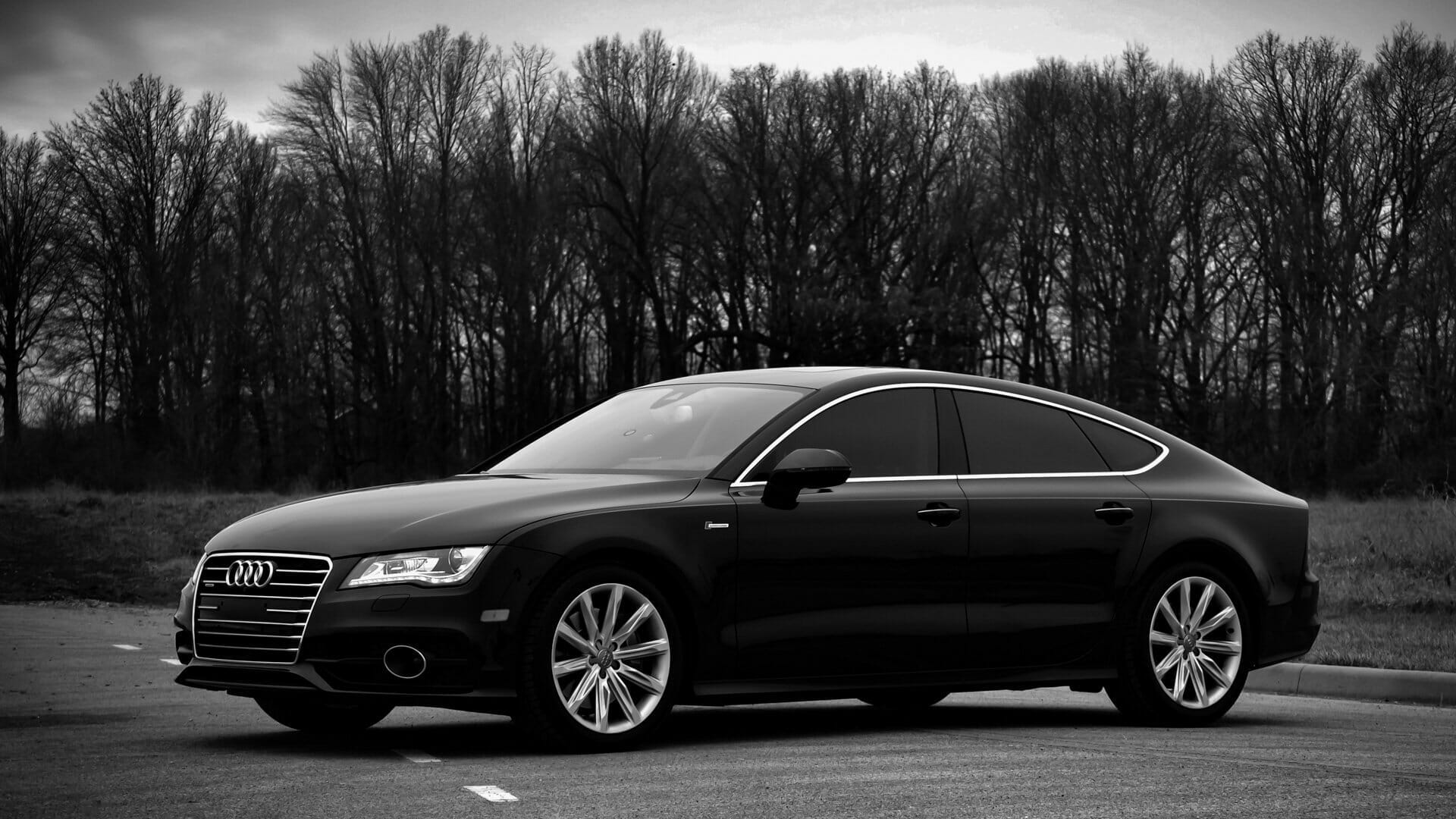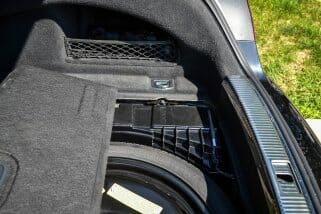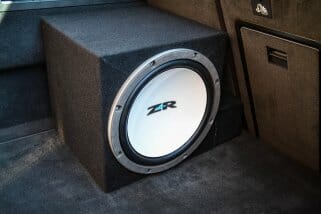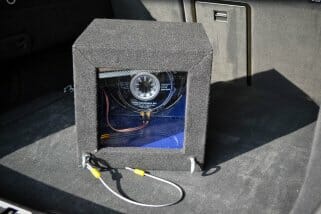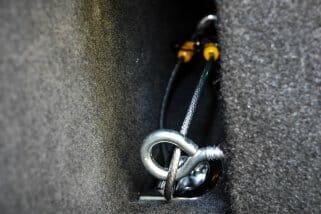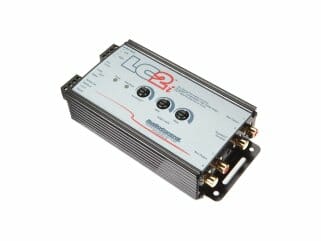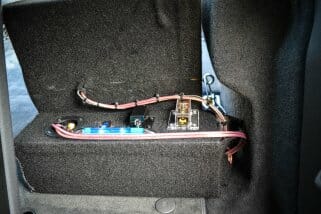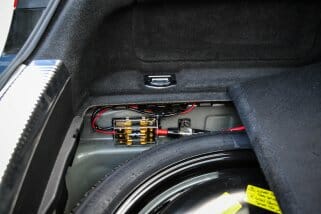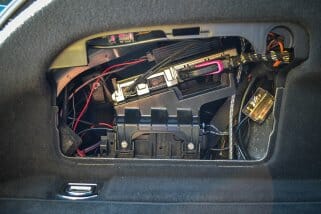Meet the gorgeous Audi A7 (Prestige Trim). Hello black beauty.
The Audi is sweet, but there was one big problem.
So I set out to remedy the situation.
Audio System Components
Subwoofer and speaker enclosure
The Alpine ZR series (Alpine SWR-304E) was the precursor to the extremely popular and hard hitting Alpine Type R (SWR-12D2) series sub. It boasts some respectable specs: RMS power of 300W, max excursion of 16 mm.
Back in 2001 I built a sealed enclosure for the SWR-304E out of 3/4″ MDF, including a 1/2″ plexiglass rear window.
The box itself was fine, but I replaced the corroding speaker wire inside it. Rather than cutting and mounting a speaker terminal cup in the box itself (which can be hard to seal and the terminals often rattle), I ran the speaker wire directly out of the box through a small hole, which was then easily sealed with silicone.
The vinyl covering on the box needed to be replaced, and this time I decided to use regular speaker carpet. I watched a few YouTube videos to brush up on the technique. For the fabric, I used Absolute C10BK speaker carpet, which was pretty easy to work with and looks great overall. My only complaint is that it is pretty thin. It was advertised as having a latex backing, but it stretched a bit too easily as I was cutting, even with brand new utility blades. For the adhesive, I highly recommend the 3M Hi-Strength 90 spray adhesive if you don’t have an air compressor spray gun.
Because I wanted to make my subwoofer box both easily removable and securely mounted, I attached two large eye screws to the back of the box. Along with some industrial strength velcro, I used the eye screws with a short cable lock to secure the box to the luggage hooks in the hatch of the car. I clamped the cable lock together using a rock climbing carabiner. This avoided having to screw directly into the sheet metal of the car.
Last, I looked around for a stylish, high-excursion speaker grill to cover the Alpine sub. At first I used a regular beehive-like grill. But, with the new Alpine amp, the sub actually hit against the grill as it oscillated. I was tempted to leave the sub uncovered, but that seemed a bit too risky as I do haul around my bass gear and other cargo regularly. Not knowing exactly how standard the hole placements are, I took a bit of a gamble and ordered the Alpine KTE-12PG. This grill was designed for the Alpine SWA-12S4 subs, but does actually fit perfectly on the older ZR series sub as well. The grill looks great, but I wish it was metal instead of plastic.
Amplifier
The Alpine MRV-M500 amplifier is small, powerful, and gets great reviews. It is a Class D digital amplifier with an RMS power rating of 300 watts x 1 at 4 ohms. Overall, it seemed a great fit. I also got the Remote Bass Level Control Knob so that I could adjust the overall output level of the amp from a more accessible location.
Line output converter
Adding an amplifier and sub to the existing factory system meant that I need to tap the powered speaker level lines. The Alpine MRV-M500 does have speaker level inputs, but I had read rave reviews about the AudioControl LC2I Two Channel Line Output Converter. Not only is the LC2I a crisp and clear active line out converter, but it had two other features that I thought were going to make my life easier (more on that later): GTO Signal Sensing, which will turn the unit on when it detects signal from the speaker inputs, and a output remote turn on lead which can be used to switch on your amplifier.
Making the subwoofer box removable
One of my requirements for this installation was that the subwoofer itself had to be removable. I described my approach to secure, but easy to remove mounting above. The wiring needed a similar approach.
To accomplish this, I built a small box to house a speaker terminal cup, remote volume level for the amp, power distribution block (for the lights), and an overall master switch for the add-on system (leaving the factory system in place). I also added a small blue light that was laying around.
Removing the sub just requires unplugging the speaker wire banana plugs, unplugging the lighting wire leads (for the lights inside the sub box and the one on this little box), turning off the master power switch, and then unhooking the carabiner on the cable lock wire.
Installation
Installing the audio components and wiring in the hatch of the A7 was pretty straightforward, but not without some issues. Because the battery is located in the spare tire well, it was super simple to attach a thick power cable and run it into a power distribution block. From there, I ran constant power leads to the amplifier and the LC2i. Likewise, there were plenty of ground mounting points to tap into as well.
Audio inputs
Getting the audio signal from the factory subwoofer was very easy. I simply spliced and soldered another speaker wire lead into the line near the connector that goes into the factory subwoofer housing. This line was the input going into the LC2i.
Note, you can run a single channel (mono) input into the LC2i if you connect it to the left channel.
The pre-amp output of the LC2i goes into the input of the Alpine amplifier.
Trouble with the LC2i and power switches
I had originally planned use Great Turn On (GTO) signal sense and remote lead output features of the LC2i to simplify the installation. The idea is that the LC2i senses the audio from the factory subwoofer lead and turns itself and the amplifier on (using the remote lead output). That way, I wouldn’t have to find a remote turn on lead from some other electrical component in the A7 to jump off of. In my setup, I also inserted a master switch into that loop so that I could be sure the amplifier was off if I wanted to disconnect the sub.
It sounded simple, but I ran into three problems.
The first was that the remote lead output on the LC2i never worked. The LC2i turned on and off properly, but the 12v output lead never had power. I was tempted to return the LC2i, but with the installation nearly complete, I didn’t want to wait for getting a replacement unit. Ultimately, I wired a remote turn-on lead by adding a fuse to an unused slot in the luggage trunk hatch fuse panel just behind the side pocket on the right side.
The second was that the LED switch I bought nearly started my car on fire. No joke!
The lead wires going to the switch were wired correctly, but either the switch was wired incorrectly or labeled incorrectly. As soon as I flipped on the switch, the lead wires got REALLY hot and started smoking! Fortunately, I had left the nut on the negative battery terminal loose, so I could quickly disconnect it once I smelled smoke!
I replaced the piece of junk LED switch I had purchased on Amazon with a different one I picked up at the local Meijer. Same wiring pattern, and everything worked just fine with the new switch.
The third problem I ran into was that the Great Turn On (GTO) signal sense sounded good in theory, but wasn’t so great in my setup. Because I was jumping off of the factory subwoofer lines, the LC2i only turns on if there is a low frequency signal. Any time a song has a significant period with no bass (for example the intro), the LC2i would turn off. When the bass kicks back in, there is a slight delay before the LC2i turns back on and the amp+sub fire up.
This was very annoying. So, in addition to wiring a direct remote turn-on lead, I disabled the GTO feature on the LC2i.
Mounting Locations
Several other A7 installations I saw had removed the factory subwoofer, and then tucked the audio components into that area. Since I wasn’t removing the factory sub, this wasn’t an option. The factory Bose amp is located in the drivers rear side pocket, and fortunately for me there was just enough space to slide in both the Alpine amp and the LC2i.
The Alpine amp fits perfectly in the empty slot of the rack, beneath the Bose amp. I trimmed off a little of the plastic edge of the rack to get it to fit nicely, and then attached it with Velcro and zip ties. I mounted the LC2i on top of the factory Bose amp using that industrial strength Velcro.
Fine tuning
I followed the directions of the Alpine amp and LC2i for tuning the system. The key parameters on the LC2i are the output and AccuBASS levels. I didn’t notice any bass roll-off in the factory system, so I adjusted the threshold so that it AccuBASS was always on.
On the Alpine MRV-M500, the main settings are gain, low pass filter (crossover level), and bass EQ. The crossover can be adjusted between 50 and 400 Hz. The bass EQ gives an adjustable boost at 50 Hz up to +12 dB.
What I didn’t realize was that by jumping the audio signal off of the factory subwoofer line, I was getting a signal that already had a low pass filter on it. Adjusting the crossover higher on the Alpine amp didn’t help past a certain point. Listening to some pieces where the bass line goes up and down, the sub cuts out a bit too much for my taste on some of the upper frequencies.
If I were doing it over, I might try to get a signal from the rear speakers instead of the factory subwoofer. If the rear speakers were getting a full range signal, then I could set the crossover for my sub a little higher. I suspect (but haven’t verified) that the rear speakers have high pass filter that blocks some of the low end, so this may not work anyway.
Further, not only is it easy to tap the audio signal from the factory subwoofer, but it also allows you to continue controlling the overall bass level through the MMI. I doubt this would work as well if you were using the signal from the rear speakers.
Overall Impressions
This was pretty straightforward installation that has made a HUGE improvement in the A7’s sound system. The mid and upper range of the sound system was great before, and now that the bass hits really hard, it has the complete package. In short, it makes the driving experience a complete joy.
Jumping the audio line off of the factory sub has a few downsides. But the big advantages are simple wiring and the fact that you can still control the overall bass level quite nicely via the MMI. For most listening purposes, I now have the MMI’s bass level at 0. Before it was maxed out at 10 all the time.
This setup met all my goals: the overall sound is amazing, the sub really doesn’t take up much of the hatch cargo space, and is removable if I ever need it. This is a nice approach if you’re looking to add some serious bass to your A7.
Disclosure of Material Connection
Some of the links in the post above are “affiliate links.” This means if you click on the link and purchase the item, I will receive an affiliate commission. Regardless, I only recommend products or services I use personally and believe will add value to my readers. I am disclosing this in accordance with the Federal Trade Commission’s 16 CFR, Part 255: “Guides Concerning the Use of Endorsements and Testimonials in Advertising.”

